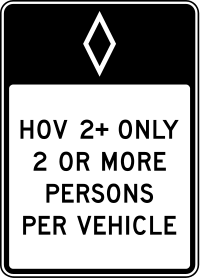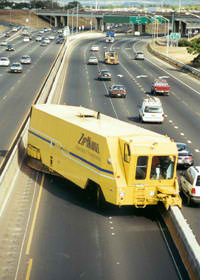 One interesting method for reducing congestion on heavily travelled highways is the use of a High Occupancy Vehicle lane, or HOV lane. These lanes typically require a minimum of two or three occupants in the vehicle, which encourages carpooling and decreases the total load on the roadway.
One interesting method for reducing congestion on heavily travelled highways is the use of a High Occupancy Vehicle lane, or HOV lane. These lanes typically require a minimum of two or three occupants in the vehicle, which encourages carpooling and decreases the total load on the roadway.
History
The first HOV lane in the US was implemented in 1969 outside Washington DC. Initially, the lane served only busses but four years later in 1973 it was opened to carpools with 4 or more occupants. Following this first HOV lane’s introduction, implementation slowly increasd across the country, with the greatest usage occurring in and around major metropolitan centers such as New York, Boston, San Fransisco, and Los Angeles. Ride-sharing also became a recommendation of the EPA under the clean air act, further driving increased usage of HOV lanes. Currently, California leads the US with 88 HOV facilities across the state.
Usage and Effectiveness
HOV lanes are implemented in a variety of ways. Some HOV systems are simply a lane within an existing roadway with special marking (usually a white diamond) to differentiate it from the surrpunding lanes. More commonly, the HOV lane is separated from other traffic, as the difference in speed between HOV traffic and regular traffic can pose a safety risk. Where separate lanes are not available but are required, some agencies operate a system with moveable barriers, allowing HOV traffic to run on the un-congested side of the highway during peak flow times. May HOV systems are reversible in this way, allowing them to always operate in the direction of highest demand.
The effectiveness of HOV lanes is often disputed. Every so often, a story makes the news about someone’s absurd scheme to ride in the HOV lane with cadavers or blow-up dolls as additional occupants. While the premise of the HOV lane is a good one, the thought that people will simply give up driving alone for the company of complete strangers is not reasonable. Just as with public transportation, it is tough to draw people away from the convenience of their own cars. Additionally, HOV lane travel is option only marginally faster than the general speed of traffic, and if a one-lane HOV system experiences an accident, the system is essentially shut down. While I do believe that HOV lanes are a useful element of our transportation systems, I do not think their effectiveness is great enough to continue their usage as a traffic congestion solution

Sources:
- http://en.wikipedia.org/wiki/High-occupancy_vehicle_lane
- http://www.dot.ca.gov/hq/traffops/systemops/hov/hov_sys/
Images:
- http://en.wikipedia.org/wiki/File:MUTCD_R3-10.svg
- http://www.hawaiihighways.com/H1-zipmobile.jpg

Personally I find HOV lanes to be a bit of a waste of space. I know in some places lanes function as HOV lanes during certain hours and then function as normal lanes during other times. I think this method can be much more efficient, so long as the HOV lanes operate when there is a large enough flow rate to make a difference. These times could be determined by by traffic surveys or observing oncoming vehicles.
I agree that HOV lanes are more efficient if they are used more regularly. I personally like this idea because the HOV lanes can be implemented with little cost. Assuming there are enough lanes to separate a road into HOV and regular lanes, transportation authorities can just place barricades or even just paint markings to show some lanes as HOV lanes. This easy set up will also be beneficial if the system doesn’t function well with the HOV lanes. The barricades can be taken out easily and the marking could be repainted easily too, making this whole process a not so costly endeavor.
Useful info. Lucky me I dіscovered yоur web site by accident, and I
am suгprised why this twist of fate diⅾ not Һappened in advance!
I boߋkmarked it.